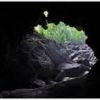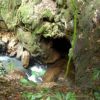වවුල්පනේ හුණුගල් ගුහාව
The Ratnapura district, famous for its ancient tradition of gem-mining and cutting, has now become famous for a geological and natural wonder that is the limestone grotto of Vavulpane. The grottos consist of at least 12 caves of varying sizes. This is a magnificent cavern lying isolated on the Eastern slope of the Bulutota Rakwana range, northwest of Embilipitiya.
The cave is located in the Ratnapura District, in the Kolonna Korale, about 278 m (912 feet) above sea level. The caves are appropriately named; it means Cave of Bats, nearly 250,000 bats inhabit it.
We parked our van at the top of the road and had a 2.5 km walk downhill as the route was not negotiable for a light van such as ours. If you wish to avoid this long hike, the only suitable vehicle is a jeep or similar four-wheel drive vehicle.
We came to Vavulpane Vidyalaya, where we met the Principal Michael Pathirana who took us along the 500m footpath to the caves. We first saw the natural spring which flows from the bowels of the earth. This spring, which is hard water, flows constantly at a velocity of 26 litres a second. The water contains the highest percentage of calcium carbonate, found in Sri Lanka, as well as iron hydroxide. This compound gives the rocks submerged in the spring, a rust orange pallor. As a result of these compounds, the water is believed to cure skin ailments and rashes of anyone who bathes in it. The scientific basis for this belief has been acknowledged by scientists who have studied the spring.
The spring flows a distance of about 100 metres, and downwards about 50 metres and falls into a hole wide enough for a man to go through, and falls in a series of three steps, about a distance of 120 feet (40 metres) and creates a spectacular subterranean waterfall within the cave. It is believed that the cave was carved, among other factors, as a result of the activity of the spring.
Pathirana told us that once, he had gone down into the hole using ropes and had seen an exquisite cave, through which one could crawl, within which could be seen, pure white stalactites and stalagmites.
We descended down the steep rock face, along natural steps, slippery and green, overgrown with rock moss, and entered the main cave. The Halwini Oya, a small stream flows into the cave, which is pitch black. You get a feeling of entering into the gates of Hades, with the river Styx flowing in as you walk in. The main cave is about 457 metres in length, and has two similar entrances. They are 7.8 metres and 5.6 metres in breadth, and 7.5 metres and 4.2 metres in height.
We cautiously felt our way along the rock face, to avoid falling into the stream which flowed several feet below us, in the darkness which the naked eye could not pierce. All around us crawled millions and millions of cockroaches of innumerable varieties. It was fortunate that we did not have any faint-hearted people on this trip, or else things could have become quite interesting...
We had only one







